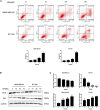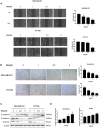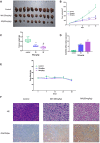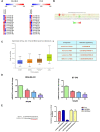Maackiain Modulates miR-374a/GADD45A Axis to Inhibit Triple-Negative Breast Cancer Initiation and Progression
- PMID: 35308218
- PMCID: PMC8930825
- DOI: 10.3389/fphar.2022.806869
Maackiain Modulates miR-374a/GADD45A Axis to Inhibit Triple-Negative Breast Cancer Initiation and Progression
Abstract
Breast cancer ranks as the leading cause of death in lethal malignancies among women worldwide, with a sharp increase of incidence since 2008. Triple negative breast cancer (TNBC) gives rise to the largest proportion in breast cancer-related deaths because of its aggressive growth and rapid metastasis. Hence, searching for promising targets and innovative approaches is indispensable for the TNBC treatment. Maackiain (MA), a natural compound with multiple biological activities, could be isolated from different Chinese herbs, such as Spatholobus suberectus and Sophora flavescens. It was the first time to report the anti-cancer effect of MA in TNBC. MA could suppress TNBC cell proliferation, foci formation, migration, and invasion. MA also exerted a significant inhibitory effect on tumor growth of TNBC. Furthermore, MA could induce apoptosis with an increase of GADD45α and a decrease of miR-374a. In contrast, overexpressing miR-374a would result in at least partly affecting the proapoptotic effect of MA and suppressing GADD45α stimulated by MA. These results reveal the anti-TNBC effect of MA in vitro and in vivo, providing evidence for its potential as a drug candidate utilized in TNBC therapy.
Keywords: EMT—epithelial to mesenchymal transformation; GADD45α; maackiain; miR-374a; triple negative breast cancer.
Copyright © 2022 Peng, Wang, Xiong, Tang, Du and Peng.
Conflict of interest statement
The authors declare that the research was conducted in the absence of any commercial or financial relationships that could be construed as a potential conflict of interest.
Figures








Similar articles
-
Isoliquiritigenin Derivative Regulates miR-374a/BAX Axis to Suppress Triple-Negative Breast Cancer Tumorigenesis and Development.Front Pharmacol. 2020 Mar 31;11:378. doi: 10.3389/fphar.2020.00378. eCollection 2020. Front Pharmacol. 2020. PMID: 32296334 Free PMC article.
-
(-)-Sativan Inhibits Tumor Development and Regulates miR-200c/PD-L1 in Triple Negative Breast Cancer Cells.Front Pharmacol. 2020 Mar 13;11:251. doi: 10.3389/fphar.2020.00251. eCollection 2020. Front Pharmacol. 2020. PMID: 32231566 Free PMC article.
-
miR-374a-5p promotes tumor progression by targeting ARRB1 in triple negative breast cancer.Cancer Lett. 2019 Jul 10;454:224-233. doi: 10.1016/j.canlet.2019.04.006. Epub 2019 Apr 17. Cancer Lett. 2019. PMID: 31004703
-
LncRNA XIST interacts with miR-454 to inhibit cells proliferation, epithelial mesenchymal transition and induces apoptosis in triple-negative breast cancer.J Biosci. 2020;45:45. J Biosci. 2020. PMID: 32098924
-
A Systematic Review on the Therapeutic Potentiality of PD-L1-Inhibiting MicroRNAs for Triple-Negative Breast Cancer: Toward Single-Cell Sequencing-Guided Biomimetic Delivery.Genes (Basel). 2021 Aug 4;12(8):1206. doi: 10.3390/genes12081206. Genes (Basel). 2021. PMID: 34440380 Free PMC article.
Cited by
-
Maackiain Mimics Caloric Restriction through aak-2-Mediated Lipid Reduction in Caenorhabditis elegans.Int J Mol Sci. 2023 Dec 13;24(24):17442. doi: 10.3390/ijms242417442. Int J Mol Sci. 2023. PMID: 38139270 Free PMC article.
-
Antitumor Activity, Mechanisms of Action and Phytochemical Profiling of Sub-Fractions Obtained from Ulex gallii Planch. (Fabaceae): A Medicinal Plant from Galicia (Spain).Molecules. 2025 Feb 19;30(4):972. doi: 10.3390/molecules30040972. Molecules. 2025. PMID: 40005281 Free PMC article.
-
PTPN21 inhibits cell apoptosis of acute lymphoblastic leukemia induced by chemotherapeutic agents via GADD45A and JNK signaling pathway.PLoS One. 2025 Apr 30;20(4):e0322273. doi: 10.1371/journal.pone.0322273. eCollection 2025. PLoS One. 2025. PMID: 40305474 Free PMC article.
-
Natural Products as Novel Therapeutic Agents for Triple-Negative Breast Cancer: Current Evidence, Mechanisms, Challenges, and Opportunities.Molecules. 2025 Mar 7;30(6):1201. doi: 10.3390/molecules30061201. Molecules. 2025. PMID: 40141978 Free PMC article. Review.
-
Role of flavonoids in inhibiting triple-negative breast cancer.Front Pharmacol. 2024 Aug 27;15:1411059. doi: 10.3389/fphar.2024.1411059. eCollection 2024. Front Pharmacol. 2024. PMID: 39257397 Free PMC article. Review.
References
-
- Aratanechemuge Y., Hibasami H., Katsuzaki H., Imai K., Komiya T. (2004). Induction of Apoptosis by Maackiain and Trifolirhizin (Maackiain Glycoside) Isolated from Sanzukon (Sophora Subprostrate Chen et T. Chen) in Human Promyelotic Leukemia HL-60 cells. Oncol. Rep. 12, 1183–1188. 10.3892/or.12.6.1183 - DOI - PubMed
-
- Bartoszewski R., Gebert M., Janaszak-Jasiecka A., Cabaj A., Króliczewski J., Bartoszewska S., et al. (2020). Genome-Wide mRNA Profiling Identifies RCAN1 and GADD45A as Regulators of the Transitional Switch from Survival to Apoptosis During ER Stress. FEBS J. 287, 2923–2947. 10.1111/febs.15195 - DOI - PubMed
LinkOut - more resources
Full Text Sources

